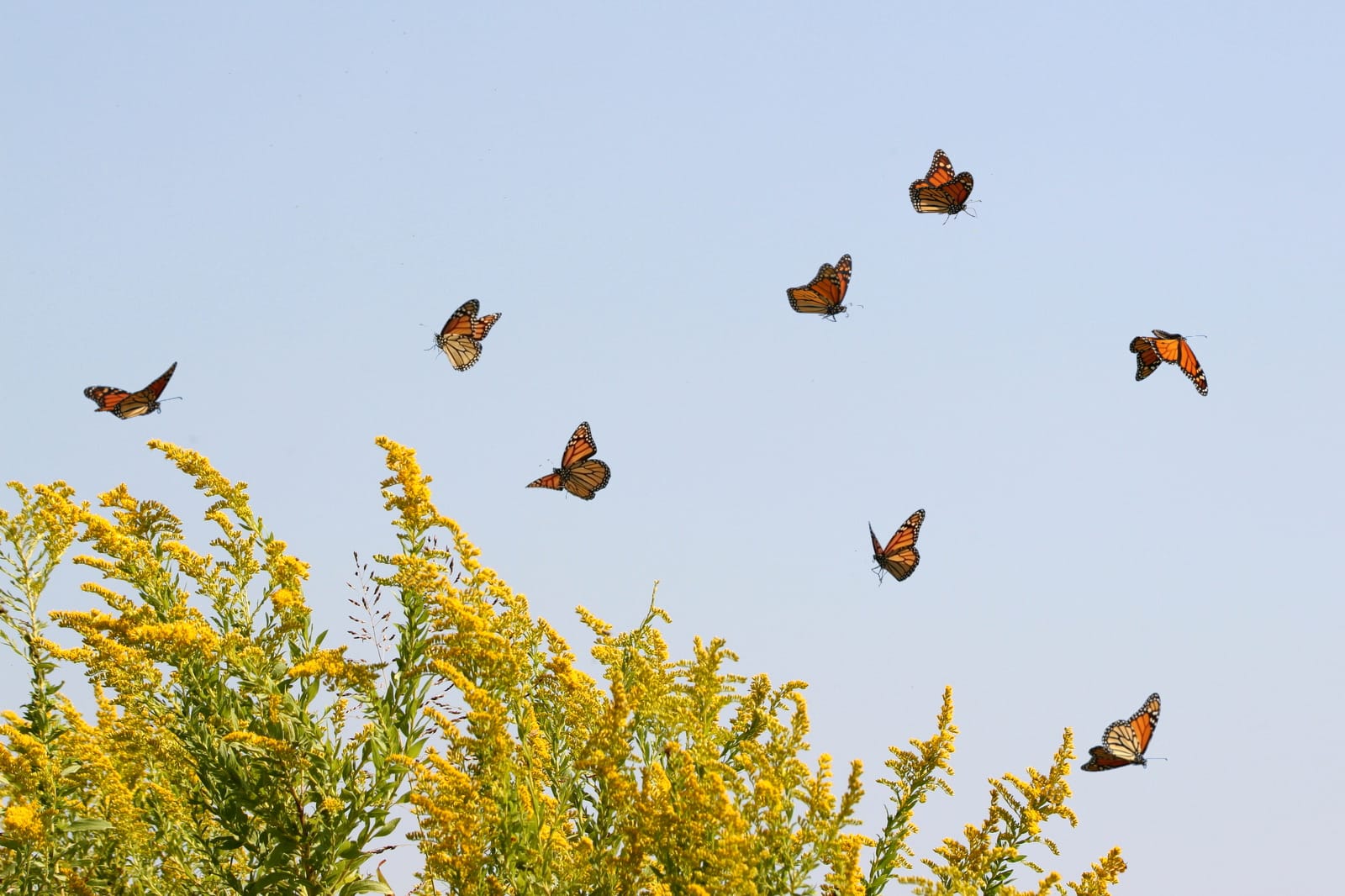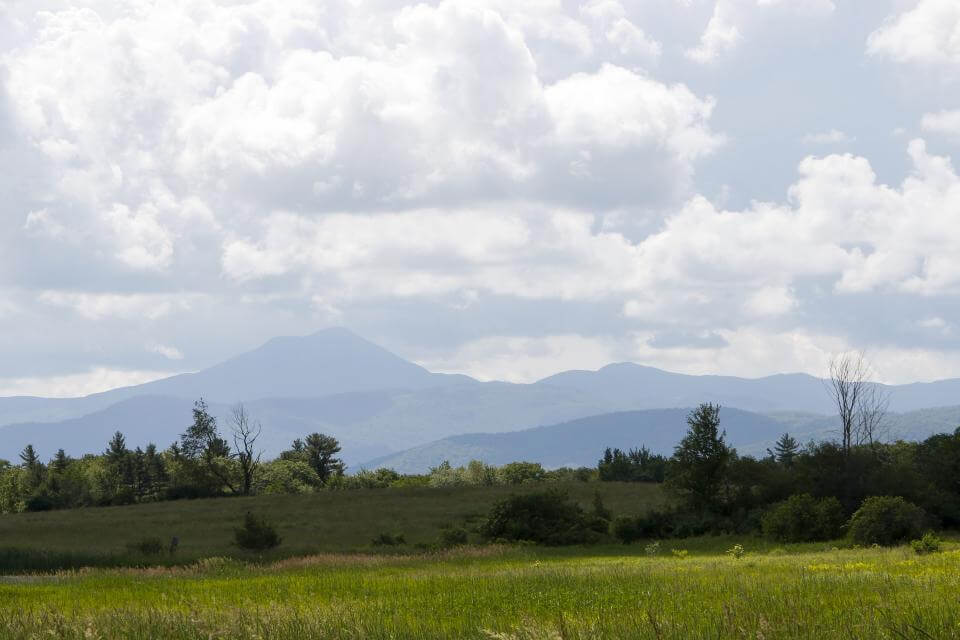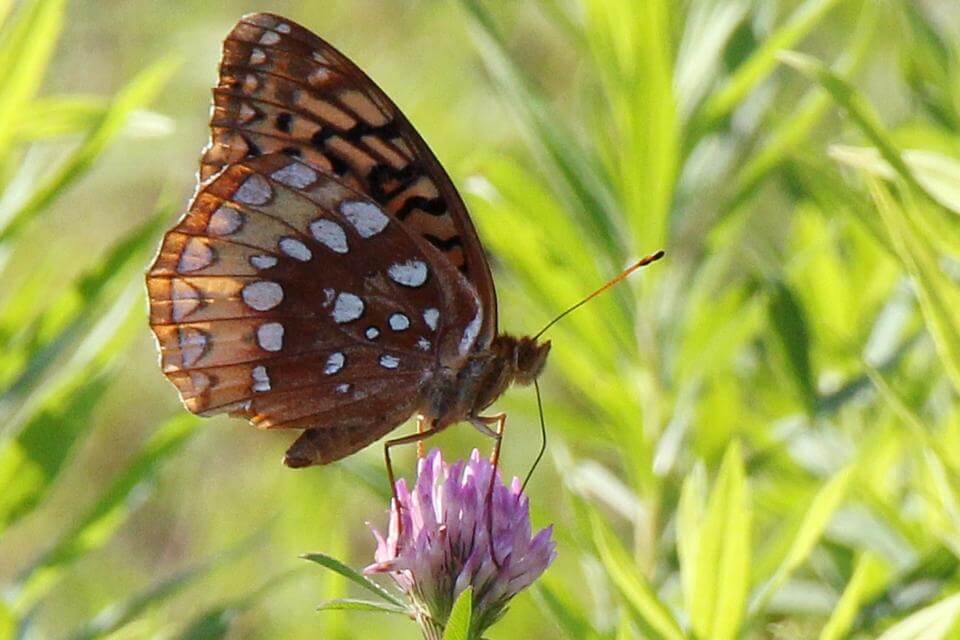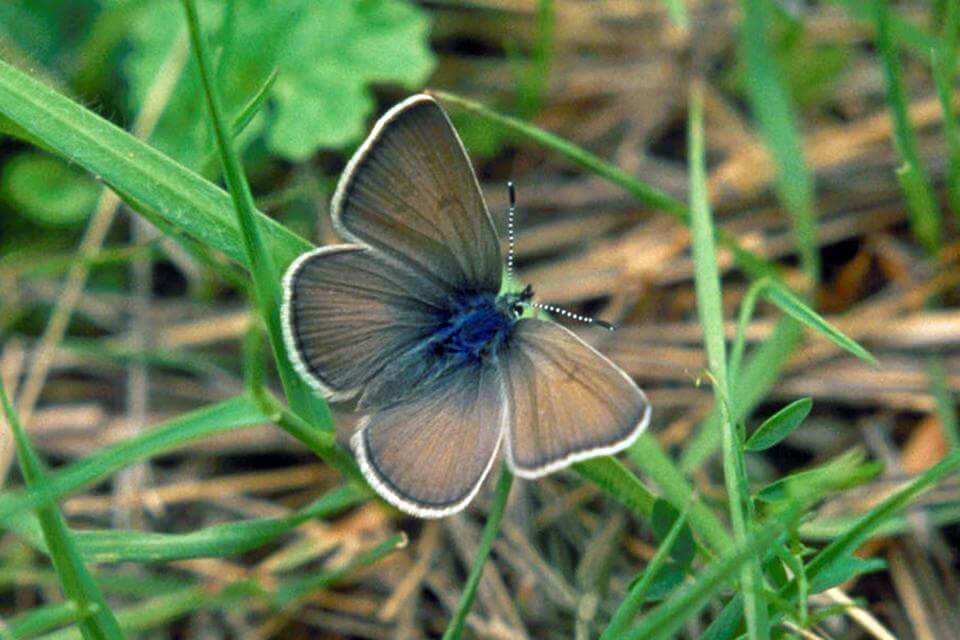Summer is here, which means pickup soccer games in neighborhood parks, Marco Polo in local pools, and soft-serve ice cream. But for nature lovers, it also means butterfly season. Just as the spring songbird migration winds down, the pageant of butterflies picks up. And specimens with whimsical names and wings seemingly painted by Jackson Pollock appear in open meadows—monarchs, great spangled fritillaries, red admirals, painted ladies, and tiger swallowtails, to name just a few. Trust for Public Land has protected forests, farmland, mountains, and meadows across the country, including many places with excellent butterfly habitats. Here is a sampling, from a community forest in New Hampshire to a National Wildlife Refuge in Texas.
Balcones Canyonlands National Wildlife Refuge (Marble Falls, Texas)

Monarch butterflies are drawn to pollinator-supporting plants such as goldenrod, which grows in the Balcones Canyonlands in Central Texas. Photo: Ken Slade
One of the best places to see butterflies in the South, especially monarchs, is Balcones Canyonlands National Wildlife Refuge. Since the vast majority of migrating monarchs pass through Texas on their way to and from Mexico each year, the state plays a critical role in the butterflies’ survival.
The monarch migration is one of life’s lovely mysteries. In spring, millions of monarchs embark on a multigenerational journey, leaving their winter range in the mountains of Central Mexico. Each butterfly covers part of the trek, lays eggs, and then dies. The offspring continue, in a sort of migratory relay race, reaching the Midwest, and eventually—several weeks and generations later—arriving across the northern United States and Canada.
But in recent decades, the monarch population has suffered a sharp decline—some estimates put it at 90 percent—and the loss of milkweed is largely responsible. Milkweed, the only plant on which monarchs will lay eggs, started to wither after the introduction of herbicide-tolerant crops in the 1990s. The resulting spike in herbicide use all but wiped out the attractive perennial, whose blossoms provide nectar for a dozen species of butterflies and moths.
Fortunately, milkweed remains abundant at Balcones Canyonlands—a 33,000-acre sweep of Ashe juniper forests and limestone canyons northwest of Austin. In the past 25 years, Trust for Public Land has added more than 3,000 acres to the wildlife refuge, most recently the once-private Peaceful Springs Preserve.
In addition, the refuge deploys other land management practices with pollinators in mind. “We have an active prescribed fire program, which sets back succession and encourages wildflowers,” says Scott Rowin, the refuge biologist. “So monarchs and butterflies are able to find a continual nectar source.”
Catamount Community Forest (Williston, Vermont)
 Catamount Community Forest in Vermont is beloved by mountain bikers, cross country skiers, and butterfly enthusiasts. Photo: Brian Mohr/Ember Photography
Catamount Community Forest in Vermont is beloved by mountain bikers, cross country skiers, and butterfly enthusiasts. Photo: Brian Mohr/Ember Photography
Just outside of Burlington—Vermont’s largest city—lies the town of Williston, which in recent decades has morphed from a quiet farming center to bedroom community. So when Trust for Public Land helped create the Catamount Community Forest, the move reflected residents’ determination to hold onto a piece of what makes Vermont the Green Mountain State.
The 393-acre property is unusual in that about a quarter is not forested, but comprised of open meadows, ponds, wetlands, and rock ledges. That makes a good venue for cross-country skiing and mountain biking—and also great butterfly habitat.
Some 30 acres are actively hayed, 10 of those on a delayed mowing schedule of every three years. In addition, a powerline runs through the forest; its grassy strip abuts the forest, creating an edge flecked with milkweed and other pollinator plants. “It makes a wonderful habitat for butterflies, as well as golden and blue-winged warblers,” says Terry Marron, a member of the town’s conservation commission.
An expert birder, Marron recalls discussions about the fate of the property after it was acquired by Williston in 2019. “People were saying, ‘Oh, it’s a forest—we need to let it all go back to forest,’” she says. “And I was like ‘Oh, no we don’t—we need a diversification of habitat.’”
In the past year, a steady parade of butterflies has fluttered through Catamount: northern azures, monarchs (the official state butterfly), mourning cloaks, black swallowtails, viceroys, common ringlets, white admirals, red admirals, painted ladies, and great spangled fritillaries, among others. Marron says that for nature lovers who enjoy both birding and butterflying—yes, that’s a term—the timing is serendipitous.
“You go out early in the morning to look for birds,” she says, “and then when it starts to warm up, you can switch to butterflies.”
Donate today to support our work protecting land that wildlife depends on—and that brings all of us closer to nature.
Hudson Farm and Mink Brook Community Forest (Hanover, New Hampshire)
 New Hampshire’s Hudson Farm in June: an inviting place for butterflies and humans. Photo: Kari Asmus
New Hampshire’s Hudson Farm in June: an inviting place for butterflies and humans. Photo: Kari Asmus
Less than 100 miles to the southwest are two more butterfly destinations: Hudson Farm and Mink Brook Community Forest, both in Hanover, New Hampshire. Trust for Public Land helped protect both properties from development in the past five years, providing permanent public access to more than 400 acres in the college town—home to Dartmouth—whose population has doubled since the 1950s.
Located in the Connecticut River Valley, the properties have plenty of wildflower-filled meadows. Minutes from downtown Hanover, Hudson Farm’s 173 acres offer several approaches to the Appalachian National Scenic Trail, while Mink Brook’s 250 acres provide connections to existing conservation lands.
Retaining meadows at both locations was important to residents like Jim Kennedy, a former member of the town’s conservation commission, and Kari Asmus, a nature photographer.
 A great spangled fritillary on red clover at Mink Brook Community Forest, New Hampshire. Photo: Kari Asmus
A great spangled fritillary on red clover at Mink Brook Community Forest, New Hampshire. Photo: Kari Asmus
At Mink Brook, where open meadows blanket the southern portion of the property, wildflowers such as common milkweed, common yarrow, and Joe-Pye weed provide pops of color in summer. “You drive along the road and all of a sudden you see an open meadow,” says Kennedy, a landscape architect. “It’s been a community treasure for a long time.”
During a recent visit to Mink Brook Community Forest, Kennedy saw viceroys, which are easily confused with monarchs. They are nearly identical, save for a black bar across the viceroy’s back. Naturalists can distinguish between the two by studying the flight pattern. “Viceroys fly very fast and don’t stop, whereas monarchs go flap, flap, glide,” he explains. “Monarchs are much slower.”
For her part, Asmus has become an expert on local Lepidoptera—the order of insects that includes butterflies and moths. She most enjoys documenting butterflies, heading with her Canon out to Hudson Farm, which Trust for Public Land bought from Dartmouth College before deeding it to the National Park Service. “There is good variation there in terms of some wetter areas and different plants like red clover and blue-eyed grass that butterflies like,” she says.
 A common ringlet visits Hudson Farm in New Hampshire. Photo: Kari Asmus
A common ringlet visits Hudson Farm in New Hampshire. Photo: Kari Asmus
At Hudson Farm, she has snapped pictures—portraits is more apt—of common ringlets on chokecherry leaves and black swallowtails atop red clover. But she doesn’t need to venture far to find her subject. Her own yard includes a field that she leaves to its own devices. So far this summer, she has spied swallowtails, northern crescents, checkerspots, viceroys, common ringlets, skippers, and white admirals. “When you start looking, we have an embarrassment of riches here,” she says.
Baskett Slough National Wildlife Refuge (Dallas, Oregon)
 A Fender’s blue butterfly, also known as the “fairy of the prairie,” spreads its wings in Oregon’s Willamette Valley. Photo: U.S. Army Corps of Engineers
A Fender’s blue butterfly, also known as the “fairy of the prairie,” spreads its wings in Oregon’s Willamette Valley. Photo: U.S. Army Corps of Engineers
It’s called the fairy of the prairie. The Fender’s blue butterfly, with its deep-blue, delicate wings, was considered extinct from World War II until the late 1980s. But in 1989, a lepidopterist named Paul Hammond discovered remnant populations in Oregon’s Willamette Valley. (The year before, 12-year-old Paul Severns had collected three males and three females. But because his guide didn’t list the butterfly as extinct, he didn’t appreciate the remarkable find.)
Ringed in black and white, Fender’s blues favor upland prairies where wildflowers, in particular Kincaid’s lupine, give sustenance to larvae and adults. According to the Xerces Society for Invertebrate Conservation, less than one percent of the original prairie habitat once available to the Fender’s blue exists today, the result of development and agriculture.
The largest concentration of surviving Fender’s blue butterflies is found in the Baskett Slough National Wildlife Refuge in Polk County, an hour south of Portland. In 2020, Trust for Public Land protected 183 acres next to Baskett Slough, a rare oak savanna ecosystem known as Smithfield Oaks.
According to the Oregon Department of Fish and Wildlife, the property—a mix of oak stands and upland meadow containing Kincaid’s lupine—is home to 10 percent of the Fender’s population in the greater Baskett Butte area. “With native prairie declines in the Willamette Valley, Smithfield Oaks is an important win for conservation of the two federally listed species,” said Laura Tesler, the Willamette Wildlife Mitigation Program coordinator, at the time of the acquisition.
With many butterflies displaying warm hues like orange, red, and brown, the Fender’s blue is easy to spot. The males are the showstoppers, with iridescent blue wings, while the females’ wings are a rusty brown. Still, you need to look closely since it is one of the smaller butterflies, with a wingspan of only an inch.
As for that 12-year-old budding lepidopterist? He is now Dr. Paul M. Severns, a professor of plant pathology at the University of Georgia—and an expert on another endangered butterfly in the Pacific Northwest: Taylor’s checkerspot.
Lisa W. Foderaro is a senior writer and researcher for Trust for Public Land. Previously, she was a reporter for the New York Times, where she covered parks and the environment.
Despite the importance and popularity of our forests, they face unprecedented threats. Take action now and urge Congress to protect our country’s forests by signing our petition today!

Donate to become a member, and you’ll receive a subscription to Land&People magazine, our biannual publication featuring exclusive, inspiring stories about our work connecting everyone to the outdoors.

